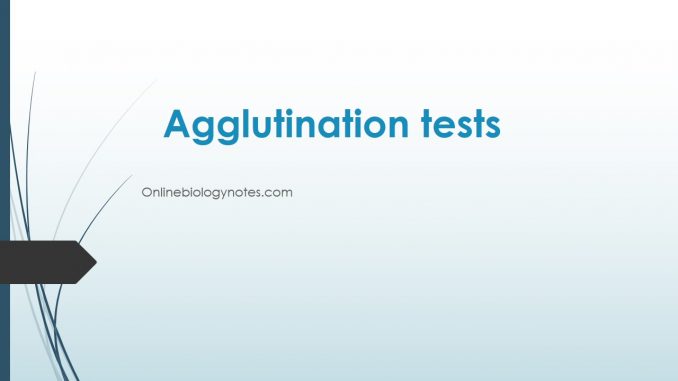
Agglutination test:
- Agglutination test use visible clumping of cell or cellular antigen by binding of antibody.
- The resulting clump or aggregate of cell is called agglutinate.
- Principle of precipitation test is similar to that of agglutination test but the only one difference is that the cellular antigen give agglutination reaction and soluble antigen give precipitation reaction.
- Agglutination test is carried out in presence of electrolyte at optimum pH of 7.4 and temperature of 37°C.
- Like in precipitate test, very high concentration of antigen gives negative agglutination test. It is called post-zone effect.
- Similarly, very high concentration of antibody also inhibits agglutination reaction. It is called pro-zone effect.
- Pro-zone effect also occurs due to high concentration of incomplete or blocking antibody (eg. IgA). Blocking antibody lack flexibility at their hinge region and fail to agglutinate cell. Agglutination occur only when antigen and antibody are in appropriate concentration.
Types of agglutination test:
1.Direct or active agglutination test:
- It is direct agglutination of cellular antigen by its corresponding antibody. For example, agglutination of Salmonella by its specific antibody.
- Similarly, agglutination of RBC by anti-RBC antibody is an example of direct or active agglutination.
2. Indirect or passive agglutination:
- In this indirect test, specific antigen or antibody are coated on surface of carrier cells such as carbon particles, latex particle, RBC or Staphylococcus cell.
- In this test, the role of carrier molecules in antigen-antibody reaction is passive.
- Co-agglutination: Eg. Staphylococcus aureus can be used as carrier molecules in passive agglutination test. S.aureus has protein ‘A’ on its cell wall that can bind with Fc region of antibody. Such S.aureus coated with specific antibody can be used to detect specific antigen. It is also known as co-agglutination.
Examples of agglutination tests:
- i. Active or direct haemagglutination test:
- It is agglutination of RBCs by anti-RBC antibodies. This test is used for blood grouping.
- ii. Indirect or passive haemagglutination assay (IHA):
- In IHA, antigen of microorganisms are coated on surface of RBC.
- Such coated RBCs are used to detect specific antibody in serum of patients.
- When antigen coated RBCs are mixed with antibody RBCs are agglutinated by antibody.
- iii. Reverse passive haemagglutination assay (RPHA):
- In RPHA, specific antibodies are coated on surface of RBCs. Such antibody coated RBC are used to detect specific antigen in sample.
- When antibody coated RBC are mixed with antigen, RBC are agglutinated.
- iv. Haemagglutination inhibition antibody (HIA) test:
- HIA test is used to detect antibody in serum of patient with haemagglutinin containing virus infection.
- Some viruses such as Influenza virus, measles virus, Arbo virus and some bacteria such as Vibrio choleriae containing haemagglutinin spike on their surface that bind RBC and agglutinate RBC.
- At first serum of patient is mixed with viral culture. Then RBC are added.
- If haemagglutination occurs, it indicates absence of antibody in serum.
- If haemagglutination does not occurs, it indicates presence of antibody in serum.
- If antibodies are present in serum then they bind with haeagglutinin on the surface of virus prevent agglutination of RBC by the virus.
- v. Coombs test:
- It is used to detect incomplete antibody.
- Incomplete antibody cannot agglutinate antigen.
- Best example of incomplete antibody is antibody produced against Rh antigen of RBC.
- At after RBC is mixed with incomplete antibody (anti-Rh antibody).
- In this case agglutination does not occur even if antibody is present. Then anti-human globulin is added.
- If agglutination occurs, it indicates positive test. Ie. Presence of incomplete antibody.
- If agglutination does not occur even after addition of anti-human globulin, it indicates negative test.
Application of agglutination test:
- For blood grouping and cross matching. Eg, Haemagglutination assay
- For identification of unknown microbial culture and for sero-typing
- For detection of antigen and antibody in clinical sample
- For serological diagnosis of certain microbial diseases such as typhoid (Widal test), typhus fever (Weil-Felix test) etc.
